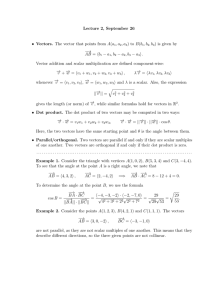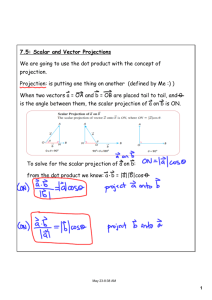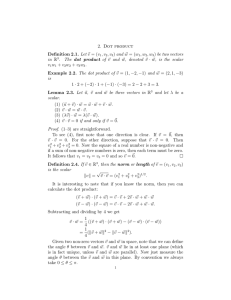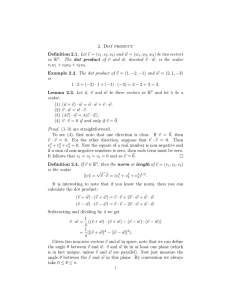Section 1.2: The Dot Product i and ~ i is the scalar
advertisement
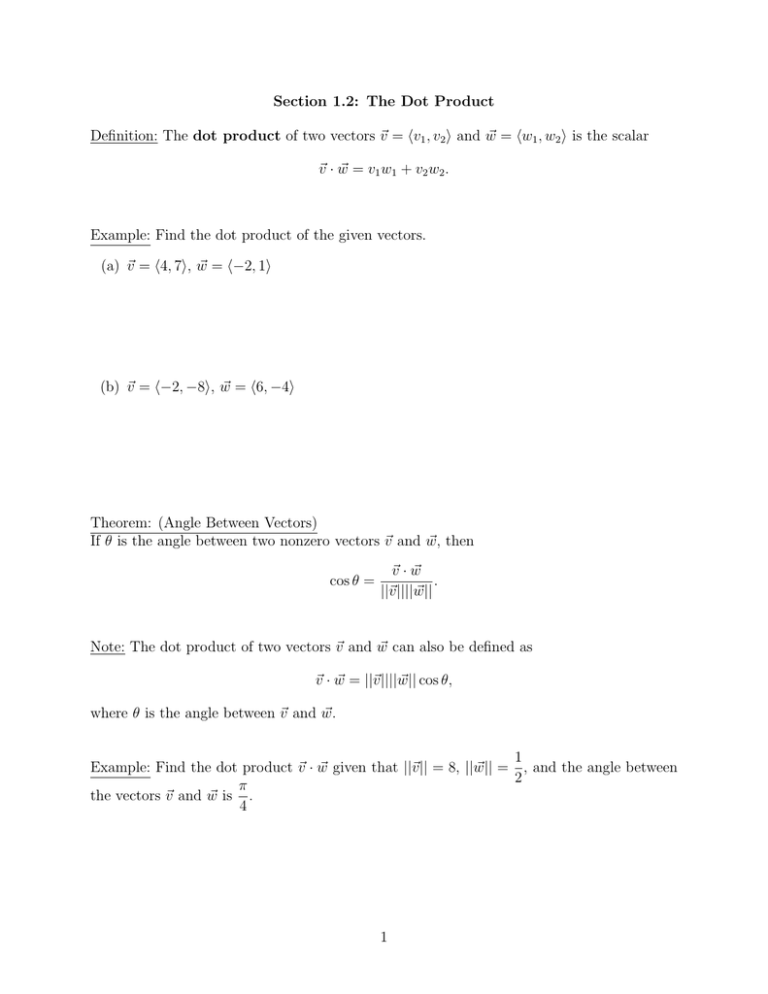
Section 1.2: The Dot Product Definition: The dot product of two vectors ~v = hv1 , v2 i and w ~ = hw1 , w2 i is the scalar ~v · w ~ = v1 w1 + v2 w2 . Example: Find the dot product of the given vectors. (a) ~v = h4, 7i, w ~ = h−2, 1i (b) ~v = h−2, −8i, w ~ = h6, −4i Theorem: (Angle Between Vectors) If θ is the angle between two nonzero vectors ~v and w, ~ then cos θ = ~v · w ~ . ||~v ||||w|| ~ Note: The dot product of two vectors ~v and w ~ can also be defined as ~v · w ~ = ||~v ||||w|| ~ cos θ, where θ is the angle between ~v and w. ~ 1 Example: Find the dot product ~v · w ~ given that ||~v || = 8, ||w|| ~ = , and the angle between 2 π the vectors ~v and w ~ is . 4 1 Example: Find the angle between the vectors ~v = h1, 2i and w ~ = h3, 4i. Example: The points A = (3, 0), B = (5, 6), and C = (−2, 1) form a triangle. Find the angle located at the vertex A. Definition: Two vectors ~v and w ~ are parallel if there exists a scalar c such that ~v = cw. ~ Two vectors are orthogonal or perpendicular if the angle between them is θ = 90◦ . Theorem: (Orthogonal Vector Theorem) Two vectors ~v and w ~ are orthogonal if and only if ~v · w ~ = 0. 2 Example: Find all values of x such that ~v = hx, 2xi and w ~ = hx, −2i are orthogonal. Example: Find all values of x such that ~v = h2, xi and w ~ = hx − 1, 3i are parallel. Definition: The vector projection of ~v onto w ~ is the vector ~v · w ~ projw~ ~v = w. ~ ||w|| ~ 2 The scalar projection or component of ~v onto w ~ is the scalar ~v · w ~ . compw~ ~v = ||w|| ~ Note: The scalar projection is the magnitude of the vector ~v acting in the direction of w. ~ 3 Example: Find the vector and scalar projections of ~v = h3, −1i onto w ~ = h2, 3i. Example: Find the distance from the point P = (2, 1) to the line y = 2x + 1. 4 Applications to Physics and Engineering Recall that the work done by a constant force F in moving an object a distance d is W = F d. However, this formula only applies when the force acts in the direction of motion. Suppose that a constant force F~ acts on an object moving from a point P to a point Q. The work done in moving the object from P to Q depends on: ~ 1. The distance the object has moved, ||D||. 2. The magnitude of the force applied in the direction of motion, ||F~ || cos θ. The work done by F~ in moving the object is ~ cos θ = F~ · D. ~ W = ||F~ ||||D|| Example: A woman exerts a horizontal force of 30 lb on a crate as she pushes it up a ramp that is 5 ft long and inclined at an angle of 20◦ above the horizontal. Find the work done on the box. 5 Example: A boat sails south with the help of a wind blowing in the direction S36◦ E with magnitude of 300 lb. Find the work done by the wind as the boat moves 150 ft. 6
